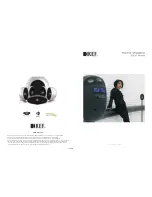
�
CANNON™ SYSTEM II TEST PROCEDURES
NOTES:
Some of the test procedures may require the user to partially disassemble the unit. Refer to the
Disassembly/Assembly Procedures
section for specific instructions.
1. Woofer Rub and Tick Test
Connect a signal generator to a power amplifier. Adjust the generator frequency to
10 Hz
and the amplifier
output to
5 Vrms.
Connect the amplifier output to the driver's input terminals. The input terminals are
molded in the driver housing near the barrier strip.
Refer to Figure 1.
No extraneous noises such as rubbing, scraping or ticking should be heard.
2. Air Leak Test
Plug the end the of the barrel.
Adjust the oscillator frequency to
10 Hz
and the amplifier output to
5 Vrms
. Apply the signal to the
positive and negative inputs of the speaker. For at least
5 seconds
, listen for air leaks around the driver
basket edge, driver housing seal area, barrier strip, or the driver's dustcap and cone surround.
Repair leaks around the driver by removing the driver and replacing the gasket under the driver flange.
3. Phase Test
Set a
DC
power supply to
8 volts.
Connect the positive (+) supply lead to the positive (+) speaker input
terminal and the negative (-) supply lead to the negative (-) speaker input terminal. The woofer cone should
move outward.
NOTE
: Supply voltage should only be momentarily applied to the speaker input terminals to avoid possible
damage to the speaker.
4. Sweep Test
Apply a
15 Vrms, 25 Hz
signal to the speaker's input connectors. Sweep the oscillator from
25 Hz to 125
kHz,
there should not be any buzzes, rattles or extraneous noise.
There should not be any buzzes or rattles from within the speaker cabinet. Redress any wire or
component that buzzes.
Figure 1. Wiring Harness and Input Connectors


























